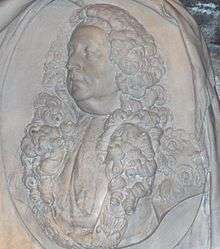John Bowes, 1st Baron Bowes
John Bowes, 1st Baron Bowes PC (I) (1691 – 22 July 1767) was an Anglo-Irish peer, politician and judge. He was noted for his great legal ability, but also for his implacable hostility to Roman Catholics.

Life
He was born in London, son of Thomas Bowes, a merchant, and was called to the Bar in 1712. He came to Ireland as a member of the staff of Richard West, the Lord Chancellor of Ireland, in 1723. He built up a large practice at the Irish Bar; was appointed Solicitor-General for Ireland in 1730, and Attorney-General in 1739. He was raised to the Bench as Lord Chief Baron of the Irish Exchequer in 1741.[1] He was appointed Lord Chancellor of Ireland by King George II in 1757.
John Bowes epitomized the severity of the 18th century Penal Laws against Irish Catholics when he ruled that: "The law does not suppose any such person to exist as an Irish Roman Catholic, nor could such a person draw breath without the Crown's permission." Such views, given that Roman Catholics made up more than 90% of the Irish population, inevitably made him bitterly unpopular, and in 1760 he was assaulted during a riot outside the House of Commons. In spite of his religious bigotry he was considered one of the outstanding judges of his time.
Between 1731 and 1742, he represented Taghmon in the Irish House of Commons.
He was considered one of the finest speakers of his time; his speech for the prosecution at the trial of Lord Santry, who was charged with murder in 1739, was described by those who heard it as a masterpiece of eloquence and logic, and led to the Irish House of Lords bringing in a unanimous verdict of guilty against Santry.
He was raised to the peerage of Ireland in 1758 as Baron Bowes, of Clonlyon in the County of Meath.[2]
He died in Dublin on 22 July 1767, and was buried in Christchurch Cathedral, Dublin. He never married, and his title became extinct on his death. He lived at Belvedere House, Drumcondra.
References
- Ball, F. Elrington. The Judges in Ireland John Murray London. 1926
- "No. 9813". The London Gazette. 29 July 1758. p. 2.
| Parliament of Ireland | ||
|---|---|---|
| Preceded by Richard Saunders William Hore |
Member of Parliament for Taghmon 1731–1742 With: William Hore |
Succeeded by Charles Gardiner William Hore |
| Legal offices | ||
| Preceded by Robert Jocelyn |
Solicitor-General for Ireland 1730–1739 |
Succeeded by St George Caulfeild |
| Preceded by Robert Jocelyn |
Attorney-General for Ireland 1739–1741 |
Succeeded by St George Caulfeild |
| Preceded by Thomas Marlay |
Lord Chief Baron of the Irish Exchequer 1741–1757 |
Succeeded by Edward Willes |
| Preceded by The Viscount Jocelyn |
Lord Chancellor of Ireland 1757–1767 |
Succeeded by James Hewitt |
| Peerage of Ireland | ||
| New creation | Baron Bowes 1758–1767 |
Extinct |